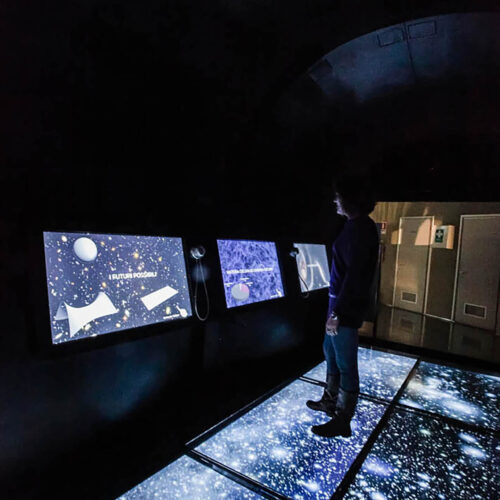Infini.To
The Planetarium of Turin
- The Planetarium of Turin
OUR SERVICES
- Graphic Design
- Video Production
- Serious game / Gamification
- Multimedia set-up
- Software Development
- 3D Production
The Planetarium of Turin – Museum of Astronomy and Space is a unique centre for the promotion of science


Visitors entering through the doors of Infini.to are greeted by a new and renovated environment. Light and sounds from Space accompany the public already from the second floors of the museum until they enter mysterious places to discover true cosmic secrets.
Much of the information we have about Space today is picked up by satellites placed on the Earth’s surface or in orbit around the Earth. Thanks to these sophisticated instruments, we can observe the sky and the objects that populate it at different frequencies, and by revisiting one of Infini.to’s stations, it is possible to interact with the electromagnetic spectrum simply by animating the display cases that contain some everyday objects used to explain how we receive information from Space.
There is not only observation from Earth: much of the information we possess today comes from space exploration, which has made great strides with the use of satellites and robotic probes, some of which are on display inside the museum and provided by Thales Alenia Space of Turin. To date, however, the only flights with astronauts are to the International Space Station, but the next big leap for mankind could be Mars. So don’t miss the chance to travel to the red planet, thanks to the new installation that takes visitors on a tour of our Solar System. From inside a real spaceship, some phases of a space voyage are retraced, experiencing with the crew the highlights of a mission, including some possible unforeseen events, such as a collision with a meteorite.
In order to undertake space flight, it is necessary to know the forces that govern the distribution and structure of cosmic objects. A fundamental component of the world around us is gravity. The Lunar environment reproduced at Infini.to allows for real space jumps, as the astronauts of the Apollo missions did.
A second station allows people to understand how much the same object placed on different celestial bodies weighs and to experience the force of gravity not only on the Moon and Earth, but also on Mars, Jupiter and a Pulsar star.
Who falls first, the feather or the hammer? On Earth, the hammer wins; on the Moon, on the other hand, the challenge ends in a tie: they arrive at the ground at the same time! But why do they fall together? Questions like this will be answered in the area devoted to the force of gravity. Other forces are not to be underestimated, however. A number of installations already in the museum allows visitors to experience the centrifugal force effect, while a new exhibit allows them to play with magnetism, allowing them to change the intensity and geometry of the magnetic field, creating bizarre figures such as dipoles and quadrupoles.
How are stars born and die? How many galaxies are there in the Universe and what shape do they have? Through the cosmic cube it is possible to find answers to these and many other questions. Immersive and technologically advanced installations allow one to traverse our Galaxy by walking through a starry field inside the cosmic saddle and watching the 3D video inside the cylinder, penetrating further and further into mysterious places, playing with dark matter and energy, and discovering the possible futures of our Universe.
